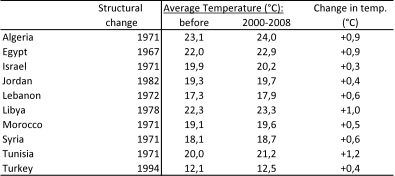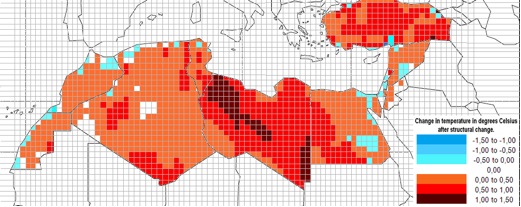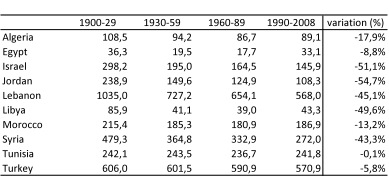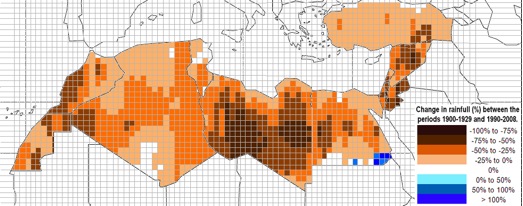Summary a) Review of literature and predictions.Middle East North Africa (MENA) countries are likely to be highly affected by the negative impacts of climate change and by all means are not immune from its devastating effects. Estimates predict a loss of 0.4 to 1.3% of GDP in MENA countries due to climate change effects, which could even rise to 14% if no mitigation and adaptation measures are undertaken. Because of its geographical position, the MENA region is one of the world’s most vulnerable regions to climate change, though with different extents on its countries. According to some studies, the rise in average temperatures and fall in precipitation levels are likely to be larger in MENA than those estimated as a world average. The expected impacts in those countries range from water loss, to soil degradation, to seawater intrusion to sea level rise (SLR). Such impacts are likely to affect all economic activities but with an extremely serious impact on agriculture and tourism, with significant loss in crop yields and an increase in salinization due to the erosion and pollution of soil. Moreover, climate change will negatively affect the ecosystem including marine ecosystems causing biodiversity loss, hence affecting individual species and significantly impacting ecosystems and their related services, on which MENA societies depend. The 2007 projections by the International Panel on Climate Change (IPCC) for the MENA region predict an increase in temperature up to 2°C in the next 15-20 years and between 4°C and 6.5°C by the end of the 21st century even though its greenhouse gas emissions (GHG) are relatively small compared to the developed countries, yet they have been among the largest producers of fuel combustion emissions in the world. The increase in temperature is likely to be accompanied by a decrease of more than 20% in the level of precipitation. Moreover, MENA countries are among the countries that are considered the world’s most water-scarce countries, have high dependency on climate-sensitive agriculture and a large share of their population and economic activity are in flood-prone urban coastal zones. Hence, the expected higher temperatures and reduced precipitation arising from climate change will increase the occurrence of droughts, which will expose additional 80-100 million people in MENA countries to water stress by 2025. In addition, in urban areas in MENA countries, a temperature increase of 1-3 °C could expose around 6?25 million people to coastal flooding. MENA governments are aware of such challenges where, for example, in a joint declaration for the Arab countries it was stated that the governments are aware of such challenges and have been undertaking the necessary adaptation and mitigation measures. Moreover, and following Copenhagen Accord, four MENA countries announced being associated with the Accord, namely Morocco, Jordan, Israel, and Tunisia.Climate change will have serious effects on agriculture sector and food security in MENA countries resulting in significant loss of crop yields. Moreover, climate change will cause severe problems associated with water management and sea level rise. The negative impact of climate change on agriculture is likely to have further negative consequences on rural-urban migration, which is likely to increase and hence further affects urbanization process, with its associated problems dealing with housing, job opportunities, and investments in infrastructure. Finally, tourism (accounting for 2-12% of GDP in MENA countries) will be negatively affected by climate change through more than one channel including high temperatures, water availability, and prices of international transport.b) Statistical evidence of climate change in MENA countries Based on new datasets at micro-spatial level, this research provides a statistical analysis of climate change for 808 MENA geographical areas from the 1900 to 2008. Results show that MENA countries have already experienced a dramatic climate change over the past century, both in terms of temperature increase and fall in precipitation.Maghreb countries have been more concerned with global warming, which generally occurred from the early 70s. The rise in temperature after this structural change is about +0.3/°0.4 degrees Celsius for these countries. In addition, global warming has accelerated in the early 2000s (+0.9/+1.2° as compared to the period before the structural change). Global warming also concerned Mashrek countries, although to a lesser extent (+0.3/+0.6 °C).Table 1: Global Warming in MENA Countries (rise in temperature, °C) Figure 1: Global Warming after the structural change
Figure 1: Global Warming after the structural change  The decrease in rainfalls is also very significant. It mainly concerns Mashrek countries. In addition, this process started earlier than global warming (often before the 1930s). In the most recent period (1990-2008), annual average rainfalls in Mashrek countries and Libya reached only 50% those recorded in the period 1900-1929. Conversely, the reduction in precipitations is much less dramatic in most Maghreb countries and Turkey (-8/-17%).Table 2: Annual rainfalls for 30 years periods (mm)
The decrease in rainfalls is also very significant. It mainly concerns Mashrek countries. In addition, this process started earlier than global warming (often before the 1930s). In the most recent period (1990-2008), annual average rainfalls in Mashrek countries and Libya reached only 50% those recorded in the period 1900-1929. Conversely, the reduction in precipitations is much less dramatic in most Maghreb countries and Turkey (-8/-17%).Table 2: Annual rainfalls for 30 years periods (mm) Figure 2: Change in precipitations in the last century (%)
Figure 2: Change in precipitations in the last century (%)
Basically, these results correlate the predictions highlighted by the literature review. As a matter of fact, we have shown that climate change is not only expected in the future, as the literature predicts, but this process has started since the 70s and concern all MENA countries.c) The impact of climate change in MENA countries’ GDP and GDP per capitaUsing standard estimators, results show that any increase in temperature by 1°C leads to a decrease in GDP per capita by 8% on average, with a range between 17% in Egypt to 0% in Turkey, Tunisia and some Mashrek countries. This range is very close to results at worldwide level which show that 1°C rise in temperature leads to a decrease in GDP per capita by 8.5% (Dell et al., 2009). However, the impact of the reduction in precipitations on GDP per capita is generally insignificant.Taking spatial autocorrelation into account, there is still some evidence of a negative impact of temperature on GDP and GDP per capita, especially in North African countries. Interestingly, these countries are those for which global warming has been the most significant (rise in temperature by about 1°C). For the other countries, the impact of temperature on GDP per capita is not significant but these countries are concerned by global warming to a lesser extent (rise in temperature below 0.5°). Overall, the impact of global warming on GDP per capita remains significant. Indeed, a rise in the temperature by 1°C leads to a reduction of GDP per capita by 5% or less, except in Egypt (15%). However, the impact of the reduction in precipitations on GDP per capita remains generally insignificant.Results at macro-level make it possible to explain growth in MENA countries with an enlarged set of variables. Results suggest that both temperature and precipitation are significant for explaining growth in these countries. In addition, key variables as education, R&D, infrastructure and communication also strongly influence growth. Finally, the pattern of international trade is detrimental to growth since MENA countries are too much specialized in low value added products which match not enough international demand.Basically, these results are consistent with the literature review which predicts negative GDP effects of global warming. It has been shown here that these negative effects have already taken place in MENA countries. d) Policy optionsThere are several initiatives that have been undertaken in MENA countries to deal with climate change. Most of such initiatives have been implemented jointly with donors as the European Commission and the World Bank. In each MENA country, several projects dealing with climate change have been set, signaling that governments are aware of the potential negative consequences of climate change. Yet, such efforts remain insufficient to create large scale, meaningful positive change. There is a need to undertake structural and comprehensive change in governmental policies. Moreover, such changes need to be well coordinated to arrive at positive impacts. Several MENA countries have still not developed their National Adaptation Programs of Action (NAPAs), following the provisions of the United Nations Framework Convention on Climate Change (UNFCCC).Adaptation measures in MENA countries should focus on simple and low cost adaptation measures building on traditional knowledge, meeting domestic and local conditions and aiming at achieving sustainable developmental goals. Adaptation policies should prioritize their interventions based on the most urgent and vulnerable areas (coastal zones or agriculture sector). Such priorities differ from one country to another. Yet there are general policies that can be adopted in the majority of MENA countries to achieve the required goals.In addition, MENA countries should focus on reducing CO2 emissions. Low carbon growth can bring significant benefits for MENA economies, including productivity gains in energy use, improved air quality, and reduced traffic congestion. There is a large room for its reduction through energy saving projects. This requires a revisit of the existing energy policies with the introduction of a new comprehensive framework where pricing and efficient targeted subsidies are its main elements. In terms of water management there are a number of adaptation measures that can be implemented including rational usage of water through introducing new pricing systems that count for political economy conditions in several MENA countries. Also there is a need to include systems for reuse of water. The issue of non-conventional measures of water supply as desalinization should be also considered.For reducing GHG emissions, capacity building initiatives and technology transfer are needed to help MENA countries develop energy efficient systems that minimize global GHG emissions, which take into consideration social aspects to minimize negative impact on the poor. The majority of MENA countries have an outstanding potential for solar energy. In the energy sector, mitigation measures should focus on switching to natural gas, utilization of cleaner fossil fuel systems as clean-coal technologies and nuclear power for energy generation, and encouragement of utilizing renewable energy sources such as wind and solar power.Hence, and despite the efforts undertaken, the room for further improvement is still wide, including consolidation of efforts, and focus on main priorities where MENA countries could adopt joint work strategies and investment in research and development and capacity building activities.

